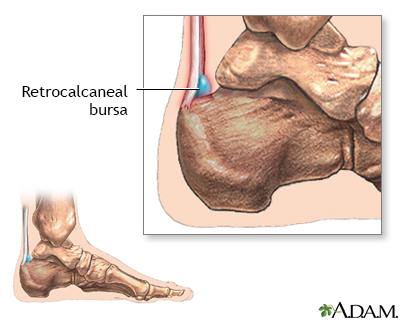Bursitis of the heel
Insertional heel pain; Retrocalcaneal bursitis
Bursitis of the heel is swelling of the fluid-filled sac (bursa) at the back of the heel bone.

Flexibility exercise in its simplest form stretches and elongates muscles. Disciplines which incorporate stretching with breath control and meditation include yoga and tai chi. The benefits of greater flexibility may go beyond the physical to the improvement of stress reduction and the promotion of a greater sense of well-being.

Retrocalcaneal bursitis is an inflammation of the bursa at the back of the heel bone. A bursa is a fluid-filled sac that acts as a cushion and a lubricant between tendons and muscles sliding over bone. Repetitive or over use of the ankle, by doing excessive walking, running, or jumping, can cause this bursa to become irritated and inflamed. Symptoms of bursitis include pain in the heel, especially with walking, running or when the area is touched.
Causes
A bursa acts as a cushion and lubricant between tendons or muscles sliding over bone. There are bursas around most large joints in the body, including the ankle.
The retrocalcaneal bursa is located in the back of the ankle by the heel. It is under the large Achilles tendon that connects the calf muscles to the heel bone.
Repeated or too much use of the ankle can cause this bursa to become irritated and inflamed. It may be caused by too much walking, running, or jumping.
This condition is very often linked to Achilles tendinitis. Sometimes retrocalcaneal bursitis may be mistaken for Achilles tendinitis.
Risks for this condition include:
- Starting a very intense workout schedule
- Suddenly increasing activity level without the right conditioning
- Increase or decrease in activity level
- History of arthritis that is caused by inflammation
Symptoms
Symptoms include:
- Pain at the back of the heel, especially with walking, running, or when the area is touched
- Pain may get worse when standing on tiptoes
- Red, warm skin over the back of the heel
Exams and Tests
Your health care provider will take a history to find out if you have symptoms of retrocalcaneal bursitis. An exam will be done to find the location of the pain. The provider will also look for tenderness and redness in the back of the heel.
The pain may be worse when your ankle is bent upward (dorsiflex). Or, the pain may be worse when you rise on your toes.
Most of the time, you will not need imaging studies such as x-ray and magnetic resonance imaging (MRI) at first. You may need these tests later if the first treatments do not lead to improvement. Inflammation may show on an MRI.
Treatment
Your provider may recommend that you do the following:
- Avoid activities that cause pain.
- Put ice on the heel several times a day.
- Take nonsteroidal anti-inflammatory drugs (NSAIDs), such as ibuprofen.
- Try using over-the-counter or custom heel wedges in your shoe to help decrease stress on the heel.
- Try ultrasound treatment during physical therapy to reduce inflammation.
Have physical therapy to improve flexibility and strength around the ankle. The focus will be on stretching your Achilles tendon. This can help the bursitis improve and prevent it from coming back.
If these treatments do not work, your provider may inject a small amount of steroid medicine into the bursa. After the injection, you should avoid overstretching the tendon because it can tear (rupture).
If the condition is connected to Achilles tendinitis, you may need to wear a cast on the ankle for several weeks. Very rarely, surgery may be needed to remove the inflamed bursa.
Outlook (Prognosis)
This condition most often gets better in several weeks with the proper treatment.
When to Contact a Medical Professional
Contact your provider if you have heel pain or symptoms of retrocalcaneal bursitis that do not improve with rest.
Prevention
Things you can do to prevent the problem include:
- Maintain good flexibility and strength around the ankle to help prevent this condition.
- Stretch the Achilles tendon to help prevent injury.
- Wear shoes with enough arch support to decrease the amount of stress on the tendon and inflammation in the bursa.
- Use proper form when exercising.
References
Biundo JJ, Canoso JJ. Bursitis, tendinitis, other periarticular disorders, and sports medicine. In: Goldman L, Cooney KA, eds. Goldman-Cecil Medicine. 27th ed. Philadelphia, PA: Elsevier; 2024:chap 242.
Grear BJ. Disorders of tendons and fascia and adolescent and adult pes planus. In: Azar FM, Beaty JH, eds. Campbell's Operative Orthopaedics. 14th ed. Philadelphia, PA: Elsevier; 2021:chap 83.
Kadakia AR, Aiyer AA. Heel pain and plantar fasciitis: hindfoot conditions. In: Miller MD, Thompson SR, eds. DeLee, Drez, & Miller's Orthopaedic Sports Medicine. 5th ed. Philadelphia, PA: Elsevier; 2020:chap 120.
Wilkins AN. Foot and ankle bursitis. In: Frontera WR, Silver JK, Rizzo TD Jr, eds. Essentials of Physical Medicine and Rehabilitation. 4th ed. Philadelphia, PA: Elsevier; 2019:chap 86.
Version Info
Last reviewed on: 8/27/2024
Reviewed by: C. Benjamin Ma, MD, Professor, Chief, Sports Medicine and Shoulder Service, UCSF Department of Orthopaedic Surgery, San Francisco, CA. Also reviewed by David C. Dugdale, MD, Medical Director, Brenda Conaway, Editorial Director, and the A.D.A.M. Editorial team.
